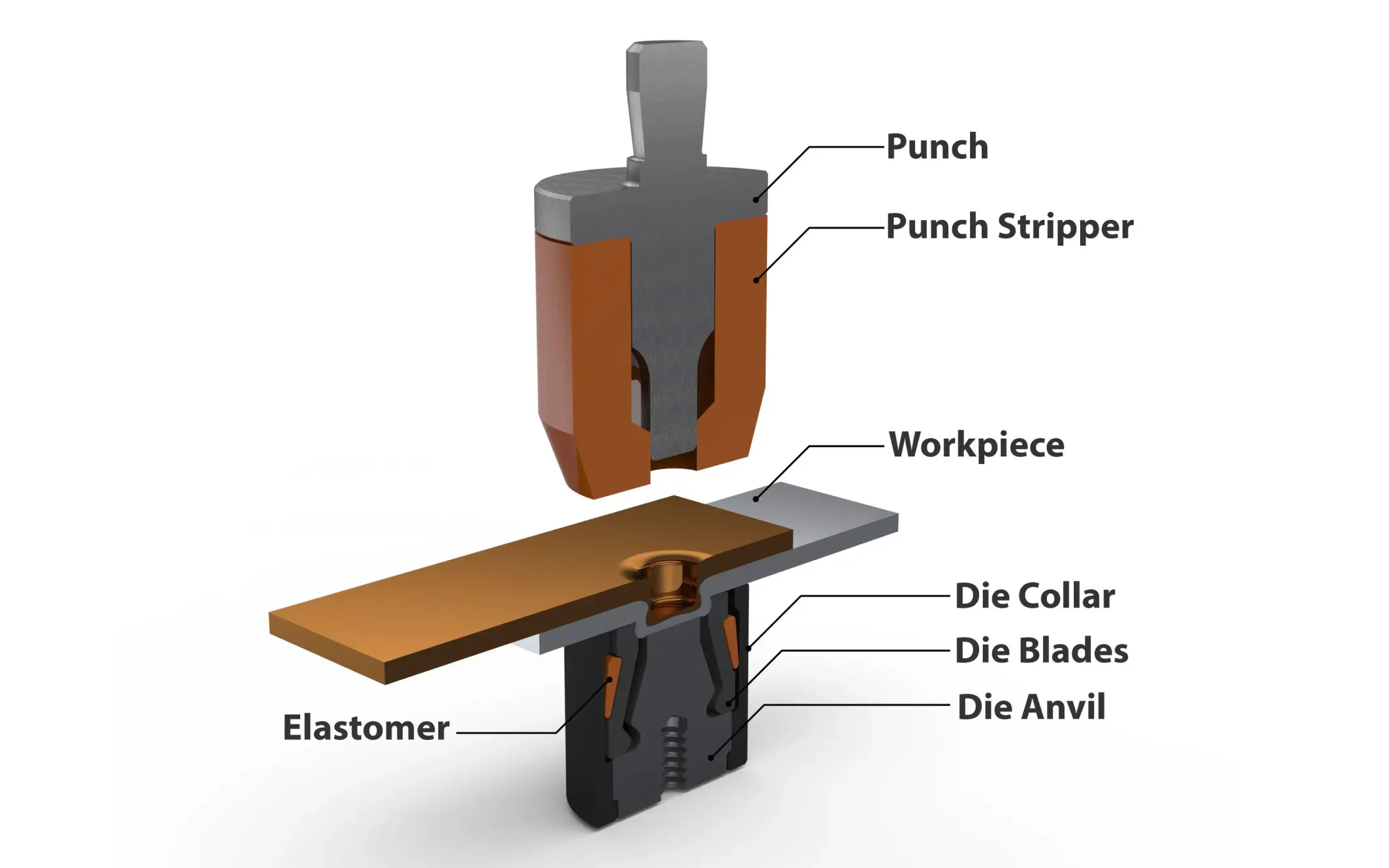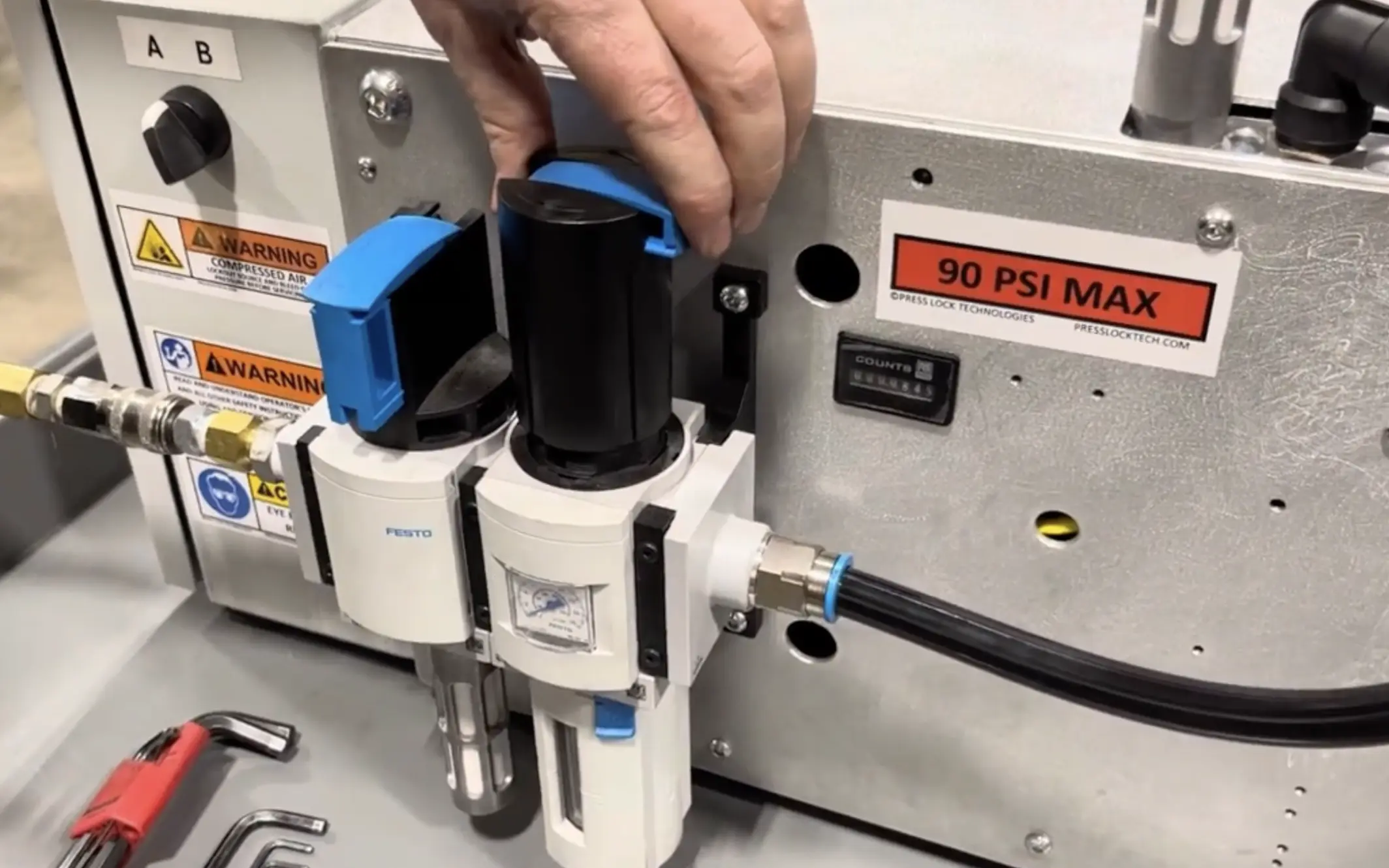.webp)
Not only is there a difference between the technology that powers clinching machines, there are also different types of clinching machines.
Some machines are:
- Mounted on the floor.
- Mounted on a desk or bench.
- Portable and can be used in different places.
Deciding on the right clinching machine for your needs can be complex.
Here’s an overview of what to consider and some tips for deciding on a type of machine.
Factors to consider when choosing a clinching machine
As always, your primary application is going to be the biggest factor in choosing a machine.
These are some of the things you should start thinking about when deciding which option is best for you:
- Start by assessing the materials and geometries you want to join. This will first help you determine what type of strength you’ll need. If a massive amount of force isn’t necessary, opting for a lower tonnage machine (and tooling) can make even a deeper throat clinching machine fairly lightweight. This is particularly useful if the parts are long or awkward to manipulate or if creating a fixture for them is challenging.
- Design the parts in a way that makes the machine easier to operate. It’s unrealistic to expect your machine operator to, for example, lift heavy parts above their head to create good joints. Sometimes, investing in designing handling devices for the part or changing the order of operations to handle smaller parts at a time will be more cost-efficient than opting for a large press. Another great option is to orient joining flanges, so that they face the outside instead of the inside of the part. This can allow smaller machines to do the work. A work cell can have two or three smaller desk-top machines and one large machine for maximum economy and efficiency.
- Evaluate the space you have available. Floor-mounted machines require significant space and are more challenging to relocate, which means you’d always need to transport parts into and out of your workshop. Desk-top and portable machines offer a lot more flexibility.
- Consider your budget constraints. Floor-mounted machines tend to be more expensive due to their higher capacity and bigger size, whereas desktop-mounted and portable machines can be more affordable.
Floor-mounted clinching machines

Floor-mounted clinching machines are stationary. They have a heavy, sturdy base bolted to the floor for stability and to absorb vibration during operation. They can handle large volumes and thick materials.
That makes them ideal for applications that require high tonnage and capacity because high tonnage requires a heavier frame, which naturally makes the machine less portable.
If you need a deeper throat machine, a floor-mounted machine will often be the best choice.
These are some of the ideal use cases for floor-mounted machines:
- Industries that require high tonnage. Floor-mounted machines are great for environments requiring high-tonnage clinching, such as automotive manufacturing and heavy machinery production.
- Continuous production lines when you’re producing high-volume and the machine will always be running.
- Large sheet metal assembly. Floor-mounted machines are commonly used for construction materials manufacturing and shipbuilding.
- Industrial workshops. They’re also used for metalworking and tool and die shops that require durable equipment for high-frequency use.
The T-Rex clinching machine from Press Lock Technologies offers a 26” throat or a 36” throat and can handle sheet metal widths of 4ft or 5ft, making it accessible from multiple sides with a larger machine setup.
Desktop mounted clinching machines

Desktop-mounted (or bench-mounted) clinching machines are more compact and convenient for tasks with limited space.
The fastening location on a desktop-mounted machine is not very deep, so you have to consider your order of operations first. If you’re able to join the parts that will be deeper early and the outside parts later, a desktop-mounted machine might be a good choice for you. They’re also a lower-risk way to try clinching out as a method.
They typically have lower capacity compared to floor-mounted machines, and they require a sturdy desk or table to attach them to (although they aren’t necessarily heavy).
They’re used in:
- Small to medium-sized manufacturing, such as electronics manufacturing and appliance assembly.
- Prototype development in R&D departments with limited space and high flexibility needs.
- Maintenance and repair shops.
- Educational institutions, like training centers, that provide tools for hands-on experience.
Our Thor Desktop is an example of desktop-mounted clinching machines that provide flexibility and integrate easily into smaller workspaces.
Portable clinching machines

Portable clinching machines offer mobility and flexibility, making them easy to store and lightweight.
They can cost less than the other two options. They’re also useful if you’re joining the materials at different planes. The machine itself can be rotated in multiple ways, so they’re great for applications where handling or moving the part is difficult.
Portable machines are typically used for:
- On-site repairs and maintenance. Field service operations like plumbing and electrical work benefit from having the machine moved to the site.
- Construction sites which typically require portable machinery.
- Small workshops that have limited space. Portable tools can also be both desktop-mounted and portable, which makes them great if you need a larger amount of flexibility and want to use the machine in multiple ways.
- Applications where it’s difficult to move the parts. High tonnage portable machines exist and some shops will use them to run full production. They can be attached to a robot arm or something similar to make them automatable.
The MooseJaw model from Press Lock Tech is an example of a portable clinching machine that is versatile and easy to use on-site.
Choosing the right clinching machine
Choosing the right clinching machine depends on your specific needs and constraints.
We’re happy to help you make a decision about which machine would work best for you. You can check out the machines we offer directly, or get in touch with us for one-on-one advice about your use case.
Take our 5-day course
Get an article every day for 5 days
Don’t have time to read everything now? Sign up and we’ll send you an article every day for 10 days.



.webp)
